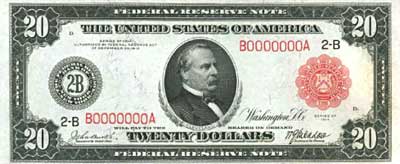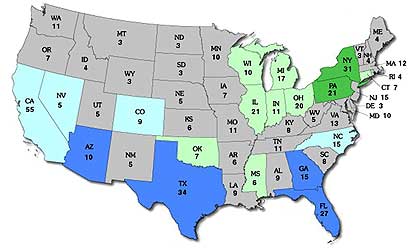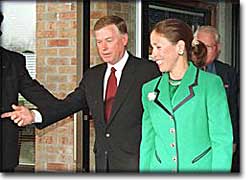7c. Selection and Succession of the President
The founders feared the masses. Cautious about granting powers to the general voting public, they created a safety valve against popular will. The American people do not technically elect their President. Electors do.

Grover Cleveland, shown on a $20 Federal Reserve Note from 1914, won the popular vote in his second election, but lost the presidency because he failed to win the electoral college.
Selection
According to the Constitution, the President serves a four-year term of office. The 22nd Amendment further requires that a President may not be elected more than twice, nor serve more than a total of ten years. The Constitution also created an electoral college to select the President.
Some of the founders wanted to select a President by popular vote, but others did not want to put that much power into the hands of the voters. Others believed that Congress should select the President, but then, what would happen to separation of powers and checks and balances? So they compromised and created a special body of electors to be selected by the states. The number of electors would be equal to the sum of a states Senators and Representatives, so that large states would have more electors than the small ones.

Some people believe that the electoral college system gives some states more or less than their fair share of votes. For example, California's population makes up about 12% the total U.S. population, but they receive only 10% of the nation's electoral votes. This map shows the changes made to the Electoral College based on the 2000 census.
Today many people believe that the Electoral College is out of date and that Presidents should be chosen by direct election, just as members of Congress are selected. By convention, state electors vote for the candidate that the people select in the general election, but they are not necessarily bound to do so.
The Electoral College also adds one nettlesome wrinkle — it is possible for a President to win more of the popular vote and lose the election. For example, if the Republican candidate gets even one more vote than the Democrat, all the state's electoral votes go to the Republican. Therefore, if a candidate wins a number of states with large electoral college members by small pluralities and carries enough states with small electoral college members to gain the necessary 270 electoral college votes, it is possible for a candidate to receive less popular votes than an opponent, and yet win the Presidential election. Five presidents — John Quincy Adams, Rutherford B. Hayes, Benjamin Harrison, George W. Bush and Donald Trump — have been elected in this fashion.
Succession

Vice President Dan Quayle became the butt of many jokes when he misspelled the word "potato" while judging an elementary school spelling bee. Like most Vice Presidents before him, Quayle failed to win the next presidential election.
The Constitution originally said little about presidential succession. It only specified that powers and duties should "devolve on the Vice President." Numerous succession situations over the years have shaped the current policy, defined in the 25th Amendment, adopted in 1967.
25th Amendment
In case of the removal of the President from office or of his death or resignation, the Vice President shall become President.
Section 2.Whenever there is a vacancy in the office of the Vice President, the President shall nominate a Vice President who shall take office upon confirmation by a majority vote of both Houses of Congress.
Section 3.Whenever the President transmits to the President pro tempore of the Senate and the Speaker of the House of Representatives his written declaration that he is unable to discharge the powers and duties of his office, and until he transmits to them a written declaration to the contrary, such powers and duties shall be discharged by the Vice President as Acting President.
Section 4.Whenever the Vice President and a majority of either the principal officers of the executive departments or of such other body as Congress may by law provide, transmits to the President pro tempore of the Senate and the Speaker of the House of Representatives their written declaration that the President is unable to discharge the powers and duties of his office, the Vice President shall immediately assume the powers and duties of the office as Acting President. Thereafter, when the President transmits to the President pro tempore of the Senate and the Speaker of the House of Representatives his written declaration that no inability exists, he shall resume the powers and duties of his office unless the Vice President and a majority of either the principal officers of the executive department or of such other body as Congress may by law provide, transmit within four days to the President pro tempore of the Senate and the Speaker of the House of Representatives their written declaration that the President is unable to discharge the powers and duties of his office. Thereupon Congress shall decide the issue, assembling within forty-eight hours for that purpose if not in session. If the Congress, within twenty-one days after receipt of the latter written declaration, or, if Congress is not in session, within twenty-one days after Congress is required to assemble, determines by two-thirds vote of both Houses that the President is unable to discharge the powers and duties of his office, the Vice President shall continue to discharge the same as Acting President; otherwise, the President shall resume the powers and duties of his office.
What happens when the presidency is vacated before an election? The Vice President becomes President, and then selects a Vice President that must be confirmed by both houses of Congress. What if something should happen to the President and Vice President at the same time? Then the Speaker of the House takes the presidency, and the President pro tempore of the Senate becomes Vice President. The line of succession then goes to the Cabinet members, in the order of their creation.
Order of Succession to the Presidency
| 1 — President of the United States |
| 2 — Vice-President of the United States |
| 3 — Speaker of the House of Representatives |
| 4 — President of the Senate Pro Tempore (becomes VP when Speaker becomes President) |
| (Cabinet Secretaries in Order of Post's Creation — see Unit 7) |
| 5 — Secretary of State |
| 6 — Secretary of the Treasury |
| 7 — Secretary of Defense |
| 8 — Attorney General |
| 9, etc. — Remaining Cabinet Secretaries |
The Vice President
What does the Vice President do? The only given constitutional duty is to preside over the Senate, a job with virtually no power since the Vice President can only vote in the event of a tie. Indeed, the nation's first Vice President, John Adams, called the post "the most insignificant office that ever the invention of man contrived."
The President, then, has almost total control over what the Vice President does. If he chooses to give him many responsibilities, The Vice President can have a significant amount of power if the President is willing to delegate it.
In recent years Presidents have given their Vice Presidents more and more to do. They have headed commissions and organized major projects. The Vice President often makes goodwill missions and attends ceremonies and celebrations. If the President regularly asks for advice, then the Vice President has some real, though indirect, power.
This dependency on the President has made it very difficult for a Vice President to successfully run for President. Only twice in American history has a seated Vice President been elected to the presidency. In 1837, Vice President Martin Van Buren succeeded Andrew Jackson, and in 1989, Vice President George Bush succeeded Ronald Reagan. In neither case, did they win reelection.







